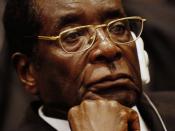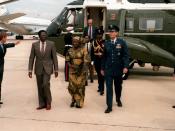- -
Economic Development in Zimbabwe
The country of Zimbabwe is one of the most economically developed on the African continent1. A fairly young political entity, Zimbabwe has only enjoyed recognized autonomy since 1980, the year in which the United Kingdom repealed its imperialistic claims to the African nation2. Despite its youth the country has achieved a level of economic development uncharacteristic of sub-Saharan African nations. Second only to South Africa in economic development, Zimbabwe's economic system is one indicative of a transitional country, a country making the transition from dependency underdevelopment to self-reliant industrialization. The purpose of this essay is to make a cursory but adequate examination of Zimbabwean socio-economic and political system, as means to analyzing the countries economic development. The ultimate purpose of this study is to provide a model of the structure necessary to achieve economic development where none previously existed. Zimbabwe is an appropriate model because the dynamics of underdevelopment to development in this country are readily apparent.
This model can be useful in understanding underdevelopment in other so called 'third-world' countries and in determining what is necessary for these countries to make the transition to industrialization.
Geography
Zimbabwe is a landlocked country in the southern, sub-Saharan area of the African continent bordered by South Africa to the South, Botswana to the West, Mozambique to the East and Zambia to the North. With an area of 391,090 km2 Zimbabwe is only slightly larger than the state of Colorado. Harare is Zimbabwe's capital and largest city with a population of 1,100,000. Containing vast amounts of rare mineralogical resources and possessing a favorable growing climate Zimbabwe's economy is drawn almost equally between the mining of minerals ($2.2 billion) and the production of staples and cash crops ($2.1 billion)3.
People
Zimbabweans are comprised of two primary ethnic groups,


